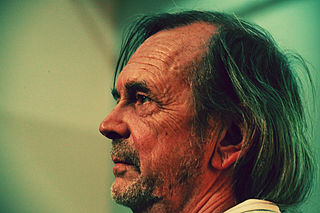
Visual technology is the engineering discipline dealing with visual representation.

Visual technology is the engineering discipline dealing with visual representation.
Visual technology includes photography, printing, augmented reality, virtual reality and video. [1]

Social constructionism is a theory of knowledge in sociology and communication theory that examines the development of jointly-constructed understandings of the world that form the basis for shared assumptions about reality. The theory centers on the notion that meanings are developed in coordination with others rather than separately within each individual.

Science studies is an interdisciplinary research area that seeks to situate scientific expertise in broad social, historical, and philosophical contexts. It uses various methods to analyze the production, representation and reception of scientific knowledge and its epistemic and semiotic role.

The sociology of scientific knowledge (SSK) is the study of science as a social activity, especially dealing with "the social conditions and effects of science, and with the social structures and processes of scientific activity." The sociology of scientific ignorance (SSI) is complementary to the sociology of scientific knowledge. For comparison, the sociology of knowledge studies the impact of human knowledge and the prevailing ideas on societies and relations between knowledge and the social context within which it arises.

Visual anthropology is a subfield of social anthropology that is concerned, in part, with the study and production of ethnographic photography, film and, since the mid-1990s, new media. More recently it has been used by historians of science and visual culture. Although sometimes wrongly conflated with ethnographic film, Visual Anthropology encompasses much more, including the anthropological study of all visual representations such as dance and other kinds of performance, museums and archiving, all visual arts, and the production and reception of mass media. Histories and analyses of representations from many cultures are part of Visual Anthropology: research topics include sandpaintings, tattoos, sculptures and reliefs, cave paintings, scrimshaw, jewelry, hieroglyphics, paintings and photographs. Also within the province of the subfield are studies of human vision, properties of media, the relationship of visual form and function, and applied, collaborative uses of visual representations. Multimodal anthropology describes the latest turn in the subfield, which considers how emerging technologies like immersive virtual reality, augmented reality, mobile apps, social networking, gaming along with film, photography and art is reshaping anthropological research, practice and teaching.

Grounded theory is a systematic methodology that has been largely, but not exclusively, applied to qualitative research conducted by social scientists. The methodology involves the construction of hypotheses and theories through the collecting and analysis of data. Grounded theory involves the application of inductive reasoning. The methodology contrasts with the hypothetico-deductive model used in traditional scientific research.
Visual culture is the aspect of culture expressed in visual images. Many academic fields study this subject, including cultural studies, art history, critical theory, philosophy, media studies, Deaf Studies and anthropology.
Visual sociology is an area of sociology concerned with the visual dimensions of social life.

Andrew Pickering is a British sociologist, philosopher and historian of science at the University of Exeter. He was a professor of sociology and a director of science and technology studies at the University of Illinois at Urbana-Champaign until 2007. He holds a doctorate in physics from the University of London, and a doctorate in Science Studies from the University of Edinburgh. His book Constructing Quarks: A Sociological History of Particle Physics is a classic in the field of the sociology of science.

Stephen William Woolgar is a British sociologist. He has worked closely with Bruno Latour, with whom he wrote Laboratory Life: The Construction of Scientific Facts (1979).

Audiovisual (AV) is electronic media possessing both a sound and a visual component, such as slide-tape presentations, films, television programs, corporate conferencing, church services, and live theater productions.

The International Image Festival is a space for meeting and discussion on topics related to visual design, electronic art, digital audiovisual creation, digital sound, and electro-acoustic, and in general, new relationships between art, design, and science and technology. Proposing an open forum for discussion in areas of digital creation, integrating art, science and technology through different activities and projects, such as: art and science conferences, seminars and workshops, calls for national and international events including new music concerts, analysis sessions, exhibitions, publications and webcast initiatives.
Hubert Knoblauch is a German sociologist, he is known for his work on Sociology of knowledge, Sociology of Religion, Qualitative research and Videography.
Digital sociology is a sub-discipline of sociology that focuses on understanding the use of digital media as part of everyday life, and how these various technologies contribute to patterns of human behavior, social relationships, and concepts of the self.
Douglas A. Harper is an American sociologist and photographer. He is the holder of the Rev. Joseph A. Lauritis, C.S.Sp. Endowed Chair in Teaching with Technology at Duquesne University, a chair funded by a grant from the Mellon Foundation.
Tharailath Koshy Oommen is an Indian sociologist, author, educationist and Professor Emeritus at the Centre for the Study of Social Systems, Jawaharlal Nehru University. He was awarded Padma Bhushan, the third highest Indian civilian award in 2008 for his services to the fields of education and literature by the President of India.
Luc Maria Alfons Pauwels is a Belgian visual sociologist and communication scientist, Professor of Communication Studies at the University of Antwerp, Belgium, and director of its Visual and Digital Cultures Research Center (ViDi). He is known for his work on visual research methods.
The International Visual Sociology Association (IVSA) is an international association for "visual sociology, visual studies, visual ethnography, documentary film and photography, public art, arts-based research, and visual literacy and education." The association holds annual conferences and publishes the journal, Visual Studies.
Leonard (Melchoir) Henny was a Dutch filmmaker, teacher, and writer, known for his socially engaged documentaries, and his pioneering work in the field of visual sociology.
"Sacrifices" is a song by record label Dreamville with American rappers EarthGang and J. Cole featuring Smino and Saba. The song was released as the first track on the label's compilation album, Revenge of the Dreamers III.
Gaye Tuchman is an American sociologist. She is a professor emerita of sociology at the University of Connecticut. Tuchman is best known for her 1978 book, Making News: A Study in the Construction of Reality, about the sociology of news production. She is a past president of the Eastern Sociological Society.
| | This technology-related article is a stub. You can help Wikipedia by expanding it. |